Your Questions
Your Questions
Q: Dr. Eppley, Hello, I was wondering if there was anything that could be done about my forehead. One side is good and the other side bulges out very far. I sent an image to better explain what I mean, the arrow is to the side I am talking about. Please let me know if there is any surgery’s or procedure that could make it symmetrical and the same as the smaller side.
Thanks
A: I believe you are pointing to the anterior temporal region (not the side of the bony forehead) which is made up of muscle and not bone. There is not a good surgery for muscle reduction in that temporal area. Botox injections is used to treat masticatory muscle areas that are not amenable to surgical reduction.
Dr. Barry Eppley
World-Renowned Plastic Surgeon
Q: Dr. Eppley, With the new custom skull implant, will there be a void between the implant and my skull? or will the implant be in full contact with my skull for the entire surface area? The implant is placed directly onto the bone (skull). Understood, however, if the volume is greater than the thickness of the implant, will there be a void between implant and skull? meaning the implant will have a curvature and the skull is flat, there will be void between implant and skull. does that make sense?
A: Silicone skull implants have some flexion so the pressure of the scalp will press it flat against the skull if it does not have a perfect fit.
Dr. Barry Eppley
World-Renowned Plastic Surgeon
Q: Dr. Eppley, Hello I would like to schedule a consult, before I do I just have one question. I’m looking to have infra orbital malar implants done. Would this interfere if I decide to have double jaw surgery down the road ?
A: Infraorbital-malar implants are placed well above the level of a LeFort I osteotomy and done through a lower eyelid incision. Thus they can be done before and after double jaw surgery without any issues.
Dr. Barry Eppley
World-Renowned Plastic Surgeon
Q: Dr. Eppley, I hope you might be able to offer an increase in calf size for me.I’ve been working out for 10 plus years and they just don’t grow 😊 😊Therefore, a polite inquiry as to whether it would be possible to get them bigger via calf implants
A: The gastrocnemius muscles can be extremely hard to hypertrophy (grow) due to their tight muscle fibers. Calf implants (2 per each calf, one for each muscle head) would be the only method to make an appreciable size change.
Dr. Barry Eppley
World-Renowned Plastic Surgeon
Q: Dr. Eppley, I’ve developed pixie ear deformity from a mini lift 3 years ago. I’m 26 years old and don’t have much skin laxity. I’ve done a lot of research into how to fix this, I’m aware some of the options include a revision facelift but also a more direct approach by reducing the ear lobe and the leaving a vertical scar at side of face . Can dr help me?
A: Unfortunately facelifts in young patients often result in adverse scarring and elongated ear lobes. While a revision facelift would be one approach for a pixie ear deformity that is not going to work for you as you have correctly surmised. The pixie ears are too long (severe) and you are too young to have any significant skin laxity. The only effective approach would be to treat it directly with earlobe shortening through an inferior helical rim technique. While effectively shortening the earlobe this will leave a fine line scar in placed of where the lower end of the earlobe now is.
Dr. Barry Eppley
World-Renowned Plastic Surgeon
Q: Dr. Eppley, , I have a very protruding rib cage while at the same time being pretty thin. Can this be reduced by rib removal/shaving safely? Does the rib cartilage regrow? Will there be life long limitations on exercising etc?
A: The question is not whether the prominent subcostal ribs can be safely reduced but whether the scar tradeoff to do is a worthy tradeoff. Unlike lower rib removal where the scars are in a more favorable location subcostal rib removal places the incision in a very visible area right over the subcostal margin. So I would be cautious about that scar location as it is not in a natural relaxed skin tension line and the scar may not do well.
Dr. Barry Eppley
World-Renowned Plastic Surgeon
Q: Dr. Eppley, Hi! I had clavicle reduction and waist narrowing with Dr Eppley on March 13, 2023. I am considering having the clavicle hardware removed. I’m interested in learning more about what it would cost, how far out it would have to be scheduled, recovery restrictions, that kind of thing. I am very pleased with the results of both the shoulder narrowing, and the waist narrowing. I healed up very well. However, one of the screws on my right clavicle feels like it has worked its way out by just a few millimeters. It’s not a huge deal, but the surrounding tissue can get a little irritated sometimes, which is why I’m asking about the hardware removal. Thanks!
A: Good to hear from you and I am glad to hear that both procedures were beneficial. Certainly after over one year of healing the clavicle hardware can be removed. The hardware removal is very different and offers a much easier recovery. It is a one hour procedure done as an outpatient. There are no significant restruction of arm movements after surgery other than I would avoid heavy lifting for the first 30 days after as a pure precautionary maneuver. The clavicle osteotomy site is undoubtably healed but whether it can sustain heavy load bearing across the healed osteotomy line which has been protected by the plate and screw fixation is one potential issue to be aware. This it may take some time for the clavicles to re-establish their strength once the fixation has been removed, thus I would simply be mindful of that in the short term.
Dr. Barry Eppley
World-Renowned Plastic Surgeon
Q: Dr. Eppley, I am interested in getting calf implanst to make my lower legs bigger. Do I need three implants per leg to do so?
A:I am not aware of a 3 implant approach to calf augmentation. There is only one muscle (gastrocnemius) with two heads in the lower legs that can be augmented with implants. (2 per calf muscle) Thus a 4 implant bilateral calf augmentation would be the standard approach which would produce a result similar to the attached imaging.
Dr. Barry Eppley
World-Renowned Plastic Surgeon
Q: Dr. Eppley, I’m interested in custom infraorbital-malar implants from Dr. Eppley post-double jaw surgery Ihave scheduled in 8 months. I’m contacting wondering how long I should wait after having the jaw surgery to come in for a consultation with him about the implants? I heard residual swelling can last many months, but wondering if that matters when dealing with planning implants. Curious when he thinks is the best amount of time to wait? Also, i’m just wondering how about how long is the waitlist for the first appointment? So i can kind of know when I should start trying to book! Thank you!
A: Given that the implant design process and getting scheduled for surgery is a minimum of 3 to 4 months it would be good to get started anytime. A 8 months postop there really is no significant residual swelling in the undereye area.
Dr. Barry Eppley
World-Renowned Plastic Surgeon
Q: Dr. Eppley,Hello, I’ve recently (6 days ago) had several surgeries for my eyes, to make them look more alert. The surgeries were a lateral canthopexy, lower eyelid raising, lower blepharoplasty, brow lowering and fat grafting to the upper and lower eyelids. I now have the issue that I look too changed, mainly from what I suspect to be an overfilling of fat in my upper eyelids area (3ml on each side). My eyes have gone from having moderate upper eyelid exposure to being almost completely hooded.
I was wondering, is a revisional upper blepharoplasty possible to remove some of the excess fat? Or is it that I’m still too swollen and some of the fat will be absorbed anyway? Thank you
A:You judge the final outcome from this surgery at 3 months not 6 days. A lot will change between now and then as the tissues heal.
Dr. Barry Eppley
World-Renowned Plastic Surgeon
Q: Dr. Eppley, Hello, I had previously made an inquiry about my shoulders a month ago and I’ve come back to make a new inquiry that would really help me if I could get some sort of disclosure on it. I have a square jawline that I’m not happy with and I was wondering what could be done to make my jawline more narrower and even give my chin an outward look instead of being flat from the front and the bottom? (pictures attached below, and I also apologize for the terrible quality once again since they had to be taken on a not so great handheld camera since I don’t have my phone available at the moment). I was also wondering how close, in terms of timeframe could I have my desired shoulder and chin narrowing cosmetic surgeries done? Thanks!
A:What you are referring to is V line surgery (aka jaw reduction surgery) There are two types which I label as Western and Eastern (Asian) methods. The chin part of such V Line surgery would be the same with either style (sliding genioplasty) It is the jaw angle part that will differ radically between the two styles. I have imaged (see attached)m the Western style where the jaw angles are narrowed but largely keeping more of their overall shape. In the Eastern style they are radically amputated which, produces a profound narrowing effect, but removes the entire shape of the jaw angles and often results in some loose sagging skin.
Both shoulder narrowing and jaw reduction surgeries can be performed together or separated by 3 months apart.
Dr. Barry Eppley
World-Renowned Plastic Surgeon
Q: Dr. Eppley, I would like to make my waist as small as possible. how many inches are patients typically able to get off?
A:On average patients report 1″ to 3″ waistline reduction but that will vary depending upon their height and body type. What I pay for attention to is the effect rather than a number. (although he two are obviously connected) In that regard I have attached some imaging to show what I believe the effects of rib removal on your waistline.
Dr. Barry Eppley
World-Renowned Plastic Surgeon
Q: Dr. Eppley, I was thinking of getting a nosejob to help improve the symmetry of my face but I’ve recently come to the realization I may have a negative orbital vector. I’d like to correct this issue but I’m not sure if I should I get a rhinoplasty before or after I do anything around my cheeks.If it is possible to fill in my cheeks before a rhinoplasty, can I receive an estimate of the recommended procedure?
A:I would do the rhinoplasty first as it will make the negative orbital vector look better and may thus affect whether you would want to treat it. (see attached imaging)
Dr. Barry Eppley
World-Renowned Plastic Surgeon
Q: Dr. Eppley, Hello, I had previously made an inquiry about my shoulders a month ago and I’ve come back to make a new inquiry that would really help me if I could get some sort of disclosure on it. I have a square jawline that I’m not happy with and I was wondering what could be done to make my jawline more narrower and even give my chin an outward look instead of being flat from the front and the bottom? (pictures attached below, and I also apologize for the terrible quality once again since they had to be taken on a not so great handheld camera since I don’t have my phone available at the moment). I was also wondering how close, in terms of timeframe could I have my desired shoulder and chin narrowing cosmetic surgeries done? if that is able to be disclosed on an inquiry. Thanks!
A:What you are referring to is V line surgery (aka jaw reduction surgery) There are two types which I label as Western and Eastern (Asian) methods. The chin part of such V Line surgery would be the same with either style (sliding genioplasty) It is the jaw angle part that will differ radically between the two styles. I have imaged (see attached)m the Western style where the jaw angles are narrowed but largely keeping more of their overall shape. In the Eastern style they are radically amputated which, produces a profound narrowing effect, but removes the entire shape of the jaw angles and often results in some loose sagging skin.
Dr. Barry Eppley
World-Renowned Plastic Surgeon
Q: Dr. Eppley, I would like to make my waist as small as possible. how many inches are patients typically able to get off?
A:On average patients report 1″ to 3″ waistline reduction but that will vary depending upon their height and body type. What I pay for attention to is the effect rather than a number. (although he two are obviously connected) In that regard I have attached some imaging to show what I believe the effects of rib removal on your waistline.
Dr. Barry Eppley
World-Renowned Plastic Surgeon
Q: Dr. Eppley, I was thinking of getting a nosejob to help improve the symmetry of my face but I’ve recently come to the realization I may have a negative orbital vector. I’d like to correct this issue but I’m not sure if I should I get a rhinoplasty before or after I do anything around my cheeks.If it is possible to fill in my cheeks before a rhinoplasty, can I receive an estimate of the recommended procedure?
A:I would do the rhinoplasty first as it will make the negative orbital vector look better and may thus affect whether you would want to treat it. (see attached imaging)
Dr. Barry Eppley
World-Renowned Plastic Surgeon
Q: Dr. Eppley, I have searched for a long time for a doctor who operates webbed necks. Due to the pictures of your homepage, I think you are very talented. So my question; I have a webbed neck and I would like to fix it with a operation. What do you think about my webbed neck? Would it be possible to fix it without many scars?
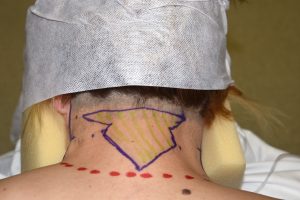
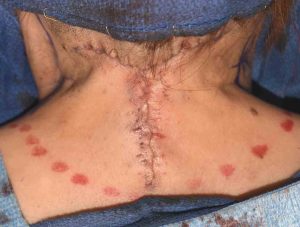 A:The proper term in webbed neck surgery is improvement of the webs rather than complete elimination of them. Such improvements are done by a posterior neck approach where the scar is on the back of the neck, half of which is hidden in the hairline. While there is a resultant scar in a female with hair it is largely hidden as the attached intraoperative pictures show on the back of the neck.
A:The proper term in webbed neck surgery is improvement of the webs rather than complete elimination of them. Such improvements are done by a posterior neck approach where the scar is on the back of the neck, half of which is hidden in the hairline. While there is a resultant scar in a female with hair it is largely hidden as the attached intraoperative pictures show on the back of the neck.
Dr. Barry Eppley
World-Renowned Plastic Surgeon
Q: Dr. Eppley, I am a 28 year old male who was born with a significant lack of muscle in my upper right leg and l was looking to discuss getting thigh implants or something that would help my leg look more proportionate to my left leg. I have tried building my leg muscles at the gym in the past but l am only able to make it look a little bit more normal. I have done much research on what doctors carry out such procedures and l see you as the best choice considering your level of experience and expertise. I see on your website that l can set up a virtual consultation but l would also be willing to travel to your office to have an in-depth assessment and see what my options are. Attached are two photos of my leg and l can provide more pictures if needed. Thank you for your time!
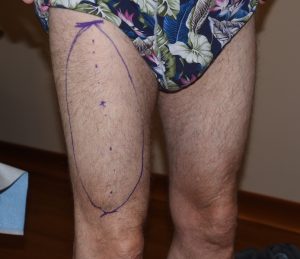
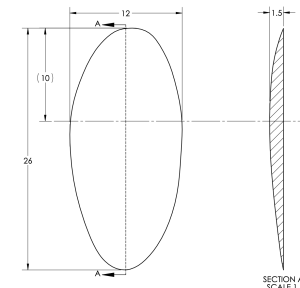 A: I think you are a candidate for a right thigh implant as such implants provide anterolateral augmentation which is exactly where your thigh deficiency is. These are made based on measurements from the patient, which can obviously be obtained in the office, but that is not an absolute requirement. We often have patients take thigh measurements on themselves (length and width as per the attached picture) which is then tramferred to a computerized design. The implant dimensions will probably not be far off from the attached basic thigh implant design.
A: I think you are a candidate for a right thigh implant as such implants provide anterolateral augmentation which is exactly where your thigh deficiency is. These are made based on measurements from the patient, which can obviously be obtained in the office, but that is not an absolute requirement. We often have patients take thigh measurements on themselves (length and width as per the attached picture) which is then tramferred to a computerized design. The implant dimensions will probably not be far off from the attached basic thigh implant design.
Dr. Barry Eppley
World-Renowned Plastic Surgeon
Q: Dr. Eppley, I have attached the facial pictures you have requested for assessment for my facial surgery. I did my own Photoshop of the desired changes.
A: When a patient does their own imaging they are showing me what they would like to visually accomplish so that is tremendously helpful in two ways: 1) it allows me to say what it and is not possible and 2) for what is possible I now know what their flavor or degree of change they desire. In regards to your imaging I can make the following comments:
1) Consistently in all three views I see forehead and crown of head skull augmentation with periorbital changes consistent with what is known as almond eye surgery. (aka lateral canthoplasties or elevated outer corners of the eyes)
2) There is high cheekbone augmentation in all views.
3) For the lower third of the face the chin has been brought slightly forward and up which only a sliding genioplasty can do. While the jaw angles have been brought down (side and oblique views) for a more defined jaw angle appearance the front view is showing an inaccurate change. In the front view the jaw angles will not stay high and narrow but will drop down and look a bit wider making the face more boxy/wider….so I would be cautious about this change. Everyone overlooks what happens in the front view when considering jaw angle surgery.
Thus all of your requested procedures seem applicable (Custom Forehead/Skull Implant, Custom Bilateral Infraorbital Malar Implants, Standard Jaw Angle Implants, and Sliding Genioplasty) with the one exception of the jaw angle augmentation.
As a final comment about imaging I would read the following statement about it and its role in facial structural surgery:
‘The purpose of computer imaging is frequently misunderstood by patients. Computer imaging is done to help determine what the patient’s aesthetic goals are. It is a method of interactive visual communication to help your surgeon understand what your specific facial reshaping goals are. It is not necessarily a completely accurate predictor of the final outcome but rather what the patient’s goals are. By knowing the target it then allows the surgeon to comment on how realistic it is and how close or far from an actual outcome then result may fall from the target based on the surgeon’s experience.’
The point being imaging, whether done by the surgeon or the patient, sets the desired aesthetic targets. This does not mean they are always precisely surgically achieved but what I do know is that you can never hit a target you do not have.
Dr. Barry Eppley
World-Renowned Plastic Surgeon
Q: Dr. Eppley, While doing the skull reductio n bone burring, Dr. Eppley mentioned that he can tell when he needs to stop. How exactly can he tell? I understand there are 3 layers in the skull, and only the outer layer (outer table) can be reduced. Is the entire outer table removed during a reduction? If not, how much is removed, and what is the factor that dictates when you must stop?
A: In skull reduction surgery the outer table of the skull is removed until one gets close to the diploic space which starts to bleed…now it is time to stop.
Dr. Barry Eppley
World-Renowned Plastic Surgeon
Q: Dr. Eppley, Thank you so much for taking the time to educate us… i am forever grateful to come across your wisdom and knowledge. I noticed there are a few articles in regards to knee lift surgery procedures which i am currently considering but would like to educate myself more about this topic prior to going ahead with anything. How long until a patient can bend their knees beyond 90 degrees post op? During recovery is it ok to bend or no bending of the knee? And how long until the patient can resume all normal regular activities etc
A: The knee lift is marked and done so the patient can have 45 degrees of knee flexion immediately after the surgery. One can then bend the knee to 90 degrees after two weeks and 120 degrees after 4 weeks and full knee flexion (greater than 120 degrees thereafter.. These knee flexion recovery guidelines will help you determine what activities you can do along way until full range of normal motion can be done after 6 weeks.
Dr. Barry Eppley
World-Renowned Plastic Surgeon
Q: Dr. Eppley, With this approach of the orbital decompression and 180 degree/inferior orbital box osteotomy, does the whole eye go down along with the upper/lower eyelids? Because I saw Dr Eppley mention before that the eyelids don’t move down with the eye if the orbital floor is lowered alone. Thanks!
A:That is correct, the eyelids do not move down with orbital decompression.
Dr. Barry Eppley
World-Renowned Plastic Surgeon
Q: Dr. Eppley, I am wrapping up the research and design thoughts, I had two questions beforehand in regard to placement of the max projection area and rim coverage of the custom cheek implants.
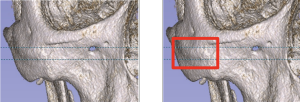

- When researching the cheekbone I see the typical “max projection” area sits parallel at or in the middle of the infraorbital foramen with its height ending just a little below the infraorbital foramen.This is a screenshot from a friends CT Scan who has more prominent cheekbones though this seems to be common when I reviewed publicly available CT scans as well. On my design I see the max projection sits above this, would it looks more natural if it was positioned lower (taking into account in the new design I will be sending over soon I will be covering the lower portion of the malar region as well with the implant) or is this higher projection recommended
- I notice on some of your designs you cover the last third of the infraorbital rim on the inner eye. What are the benefits of this and would I benefit from it/would it improve the result?
A:The first question you ask defies a precise answer as it does not factor in the thickness of the overlying soft tissues nor the angulation of the cheekbone. So the effect of the relatively minor change in the location of the maximum projection of malar implants can not be precisely predicted for any patient a bed on their CTR scan alone.
Unless one wants to have the implants placed through a lower eyelid incision or go intraoral and risk permanent numbess of the cheek and upper lip it is best to avoid getting too much implant coverage in the medial infraorbital region. It is all about minimizing trauma to the infraorbital nerve.
Dr. Barry Eppley
World-Renowned Plastic Surgeon
Q: Dr. Eppley,I am interested in the skull reshaping procedure and have a few follow-up questions:
– 1) What is the estimated size/position of the scarring for the parietal reduction (third image from previous email)? Is there a reference photo or another visual depiction I can look at to get an idea? Would it be something like an FUT hair transplant scar?
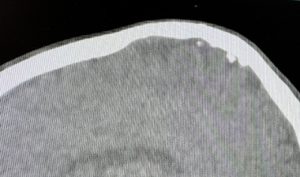 – 2) One concern I have about the sagittal reduction is what looks to me to be a “thin” area of skull along the crest at the top of the head (CT scan images attached to this email). Dr. Eppley mentioned this during the consultation, however I just wanted to call attention to it again. It seems like it could limit what can be done in that area and I want to keep my expectations realistic and be as safe as possible about the procedure.
– 2) One concern I have about the sagittal reduction is what looks to me to be a “thin” area of skull along the crest at the top of the head (CT scan images attached to this email). Dr. Eppley mentioned this during the consultation, however I just wanted to call attention to it again. It seems like it could limit what can be done in that area and I want to keep my expectations realistic and be as safe as possible about the procedure.
– 3) As far as the frontal implant to address the “dip”, I would like to keep the current hairline location as much as possible and mostly address the contour to the top of the head. In other words, I would like to avoid the impression of a very elongated forehead from the front view. This isn’t something I noticed too much of in the photoshop images but just a point I wanted to raise.
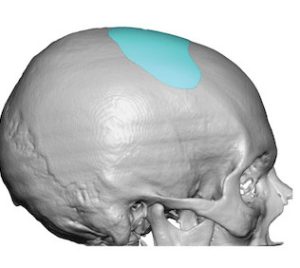
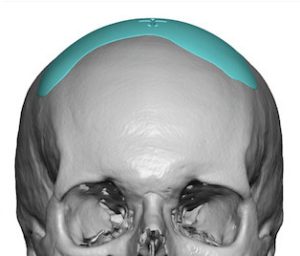 – 4) Last, I noticed on your website that there are 3D-rendered images of the skull topology scans with and without the blue colored implants for some of the patient case examples. Can I can be sent an image like that once the implant is modeled to get a better understanding of the size, shape, and position of the implant itself? I would like to have as much information as possible. I have my own copy of the 3D scan disk and would like to compare the images.
– 4) Last, I noticed on your website that there are 3D-rendered images of the skull topology scans with and without the blue colored implants for some of the patient case examples. Can I can be sent an image like that once the implant is modeled to get a better understanding of the size, shape, and position of the implant itself? I would like to have as much information as possible. I have my own copy of the 3D scan disk and would like to compare the images.
A:In answer to your sagittal crest skull reshaping questions:
1) The pictures you have sent are not ideal to show the incision location for parietal skull reduction incision but I have attached one of your pictures to try and show its location.
2) As you have noted in the CT scan and as was its purpose there are limits as to how much sagittal ridge reduction can be safely done.
3) The coronal dip skull implant would not affect the frontal hairline, it is simply not that big.
4) Implant designs are done through a third party, 3D Systems, who only create them once the process is initiated. However I can show you examples of your implant concept as seen in the attachments.
Dr. Barry Eppley
World-Renowned Plastic Surgeon
Q: Dr. Eppley, Hello, I am in Australia and saw some of your occipital bone reduction work online. Do you know any surgeons in Australia who do similar work to you? I’ve never heard of such surgery here and I have an occipital bone which is quite pronounced which I feel I would like to look into getting it reduced. Thanks so much
A:I know of no surgeons in Australia who perform any form of aesthetic skull reshaping surgery.
Dr. Barry Eppley
World-Renowned Plastic Surgeon
Q: Dr. Eppley, I’m interested in a skull reshaping surgery. I was wondering that could it be done before Face lift surgery or after? I’m 42 years old.
A:Whether you should do skull reshaping surgery before or after a facelift depends on what type of skull reshaping surgery you need. The term ‘skull reshaping’ is a general term which refers to a collection of over 30 different specific skull procedures. To provide information on what skull reshaping procedure(s) would be appropriate for your needs I would first need to know your exact head shape problem from which I can then determine how to treat it. This will require a more detailed description of your concerns, and head reshaping goals and any pictures which so illustrate. From this information then I can accurately answer the question of how it would or would not affect facelift surgery.
Dr. Barry Eppley
World-Renowned Plastic Surgeon
Q: Dr. Eppley, I know it has been a long time since I have reached out with any comments about my implants I had gotten done with Dr. Eppley, and there are no complaints or issues whatsoever. Everything is stabled and seems to have been well integrated.
My only question for Dr. Eppley would be about the possibility of contact sports such as wrestling? Would there be any issue with involving myself in sports such as that regarding my implants or should I be fine to proceed?
Thank you very much and hope everyone is doing well!
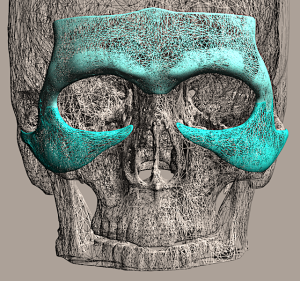
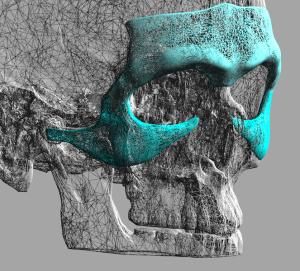 A: Good to hear from you after a few years from your custom periorbital facial implant surgery. You should have no problems with participating in all sports including wrestling. Your facial implants are well healed at this point and should never be able to be dislodged or displaced short of extreme external trauma of which sporting activities does not fall into that description.
A: Good to hear from you after a few years from your custom periorbital facial implant surgery. You should have no problems with participating in all sports including wrestling. Your facial implants are well healed at this point and should never be able to be dislodged or displaced short of extreme external trauma of which sporting activities does not fall into that description.
I wish you continued success and happiness as you continue on your upward trajectory in life.
Dr. Barry Eppley
World-Renowned Plastic Surgeon
Q: Dr. Eppley, My right eye brow has uneven bone little bit prominent could you please help me correct it.
A:For brow bone asymmetry due to a greater prominent on one side this is often a reflection of an overgrown frontal sinus on one side. The key question is whether its reduction can be done by burring or a bone flap setback, usually it is the latter that is needed. But I would have to see some pictures to determine its level of prominence.
Dr. Barry Eppley
World-Renowned Plastic Surgeon
Q: Dr. Eppley, I sent a few photos that you analyzed and you indicated that one side of the face droops lower than the other. Can this be corrected by a face lift or any other measures.
A:It is not that one side of the face droops, it is that one side of the face is structurally lower than the other side. Drooping is a soft tissue problem while structural asymmetry is a bone problem. Thus a facelift will not be effective.
In facial asymmetry the first and most important question when considering what can be done is what areas bother the patient the most? What do you see that brought your attention to the asymmetry? Facial asymmetries are complete (top to bottom) but not all areas of asymmetry can be effectively corrected, some have better value in doing than others. Thus the need to prioritize the area(s) from which then I can tell you what can or can not be done.
Dr. Barry Eppley
World-Renowned Plastic Surgeon
Q: Dr. Eppley, I have some questions about two stage skull augmentation:
1. How do the scalp expanders work?
2. Does it hurt to have them?
3. How long do they last until permanent implant?
4. Can the scalp expanders be placed anywhere on the skull?
5. Will the scalp expanders alter the appearance of the face(eyes) if used to widen skull? (Not wanting to stretch face)
6. Before any implant is put inside head can I have blueprints of the implant(s) so I can 3d print them and test the look of the implant on my skull?
7. I genuinely believe I look better with a wider skull and have pictures to prove my belief. I add volume to my hair and have been sculpting it for a decade in a way to achieve the desired look of my skull. I want to have as much widening of my skull possible so that’s why I inquire about the scalp expansion.
I would like to discuss in more detail the desired look I would like to achieve with Dr Eppley before any implant models are made. I have pictures if that is necessary. I can also video chat with him again to show him in person if that’s better for him.
A:In answer to your two stage skull augmentation questions:
1) Scalp expanders work like pregnancy….an internal slow pressure on the overlying skin to ultimately allow for a bigger mass underneath it.
2) Beyond their initial surgical placement, no.
3) The usual time period for scalp expansion is between 6 and 12 weeks before the permanent implant is placed depending upon how much scalp expansion is needed. (which is based on the size of the custom skull implant)
4) Yes
5) Unless the scalp expander is placed in the forehead it will not alter the appearance of the face.
6) You are referring to the .STL files of the implant designs. They are available from the manufacturer once the final implant design is completed but not during the various stages of the implant design. Setting an implant model on your head is not all that helpful as it will not sit properly as it is placed on the outside of the scalp as opposed to under the scalp where it will actually reside. Thus it is not a very accurate representation of the final aesthetic result.
7) Many skull augmentation patients, if they have hair, have long demonstrated the benefits of a larger skull base through hair manipulations. Thus I don’t question any patient’s aesthetic desires. I am only focused on what can I achieve in the safest and most effective surgical process. I think in your case for added head width the key question is whether one needs a one vs two stage skull augmentation approach. The best way to figure that out is imaging of your pictures to show the different potential outcomes between the two approaches.
Dr. Barry Eppley
World-Renowned Plastic Surgeon

